Arab Spring
This is the sighted version that was marked on April 15, 2021. There are 10 pending changes that have yet to be sighted.
![]()
This article is about the protests in the Arab world. For the book, see Tahar Ben Jelloun.
The Arab Spring (Arabic الربيع العربي, DMG ar-Rabīʿ al-ʿArabī) or Arabellion is the name given to a series of protests, uprisings, and revolutions in the Arab world that began in December 2010. Beginning with the revolution in Tunisia, these revolutions were directed against the authoritarian regimes and the political and social structures of several states in the Middle East (Mashreq/Arabian Peninsula) and North Africa (Maghreb and Egypt). Originally, the term had a positive connotation and it was hoped that the human rights situation in the countries concerned would improve; in the meantime, this image has been reversed.

Arab States: Head of state overthrown/resigned Government reshuffled following protests Popular Uprising/Civil War Mass protests Riots/Protests No incidents known Non-Arab states: Protests in non-Arab states No incidents known
Designation
In both the German and the international press, the term "Arab Spring" has become widely accepted, an allusion to the Prague Spring of 1968. However, because of the not clearly defined space in which the protests took place and other aspects, other terms are also used. The Blätter für deutsche und internationale Politik refer to the events as the "Arab revolution". The Frankfurter Allgemeine Zeitung uses the new-found term Arabellion, a portmanteau of Arabic and rebellion. Particularly because of the protests in Iran, the term "protests across the MENA region" can also be found in English. Due to the electoral success of Islamist parties after the protests in many Arab countries, the events were also called "Islamist spring" or "Islamist winter".
Events
On December 17, 2010, protests against the government of head of state Zine el-Abidine Ben Ali began in Tunisia after vegetable vendor Mohamed Bouazizi set himself on fire in Sidi Bouzid as a result of police brutality and humiliation. Within a few weeks, mass unrest broke out across the country and spread to several countries in North Africa and the Middle East over the next few months.
The mass protests have so far led to the ouster and flight of Tunisian strongman Zine el-Abidine Ben Ali and the resignation of Egyptian President Husni Mubarak. Yemen's President Ali Abdullah Salih stepped down in late 2011 after more than 30 years of rule. Libya saw a civil war in which rebels, backed by NATO, overthrew head of state Muammar al-Gaddafi, while a civil war is still ongoing in Syria. In other countries of the Arab world, there were government reshuffles and political reforms. In addition, social movements in other parts of the world also refer to the Arab Spring.
Egypt
→ Main articles: Revolution in Egypt 2011 and State crisis in Egypt 2013/2014
The uprising in Egypt began on 25 January 2011, the "Day of Rage". On 11 February 2011, the long-time president Husni Mubarak resigned and a military council took power. This council assured the demonstrators of free and democratic elections and the repeal of the emergency law that had been in force for 30 years. Mubarak was sentenced to life imprisonment on 2 June 2012. On August 21, 2013, an Egyptian criminal court ordered Mubarak released from prison. A day later, he was transferred to Maadi Military Hospital in Cairo, where he was placed under house arrest. On May 21, 2014, Mubarak was sentenced to three years in prison for embezzlement. In November 2014, a case against Mubarak for the deaths of more than 800 demonstrators during the spring 2011 protests was dropped. In January 2015, the prison sentence imposed in May 2014 for corruption was initially lifted, but was confirmed on 9 May 2015.
In the elections between late 2011 and mid-2012, the Muslim Brotherhood, together with other Islamic parties, won a majority in parliament as well as in Egypt's Constituent Assembly; their party leader at the time, Mohammed Mursi, won the presidential election. As a result, protests by liberal, leftist, and secular forces escalated in late November 2012 after Mursi granted himself additional powers over Egypt's judiciary. On November 29, the Constituent Assembly also approved a draft of a new constitution that invokes, among other things, the "principles of Sharia law." This again led to demonstrations, which ended with a military coup. The military appointed Adli Mansur, a former Mubarak official, as acting president until new elections were held in May 2014. In the new elections, Abd al-Fattah as-Sisi was elected president.
The involvement of Ultras in the Arab Spring, particularly in Egypt, caused an international sensation.
Algeria
→ Main article: Unrest in Algeria 2010-2012
The unrest in Algeria has been spreading since 5 January 2011 out of anger over massively increased staple food prices. They were sparked spontaneously by individual events and were not uniformly organized. One of the opposition's central demands, the lifting of the state of emergency that had been in force for 19 years, was met by the Algerian government on 22 February 2011. However, there were still reports of unrest and demonstrations until mid-April.
On 5 October, a demonstration to mark the anniversary of the 1988 democracy movement was nipped in the bud by the arrest of its initiators. At the end of April 2012, riots broke out again after a street vendor set himself on fire in protest against the removal of his stall.
Bahrain
→ Main article: Protests in Bahrain 2011
The protests in the Gulf Kingdom of Bahrain began on February 14, 2011, when a few hundred demonstrators set up an illegal tent camp in the central Pearl Square in Manama. The predominantly Shiite population is protesting primarily against the Sunni royal family of Hamad bin Isa Al Khalifa. On the night of February 16-17, the tent camp was cleared by special police units, leaving four people dead. In the weeks that followed, tens of thousands of people demonstrated. On March 14, Saudi Arabia deployed 1,000 troops to the country at the request of the Bahraini government, and a state of emergency was declared the following day. The Bahraini opposition considered this invasion a declaration of war as well as an occupation by foreign troops. Bahraini troops took action against demonstrators.
Over the next few days, all protests were violently put down. Some Shiite ministers and high judges resigned in protest over this. Numerous people were arrested. The state of emergency was lifted on 1 June 2011. From September 2011, there were repeatedly larger or smaller protest rallies, the protests during the Formula 1 race in Bahrain in 2012 became particularly well known.
Djibouti
→ Main article: Protests in Djibouti 2011
In Djibouti, thousands of people demonstrated against President Ismail Omar Guelleh on 18 February 2011, partly because he was running for a third term after a corresponding amendment to the constitution. The government promised reforms, and there was also a wave of arrests. According to the opposition, the presidential election on 8 April 2011, in which Guelleh was re-elected, was not fair.
Iraq
On 22 February 2011, demonstrations took place in Basra in southern Iraq. On 25 February 2011, after Friday prayers, demonstrations were reported for the first time in other parts of the country, in which several people were killed. The cause was anger over social injustice, in particular corruption and high unemployment were denounced. Some of the rallies ended violently when participants tried to storm government buildings in several cities. The largest demonstrations took place in the cities of Mosul, Fallujah (predominantly inhabited by Sunni Arabs), Baghdad and Basra (predominantly inhabited by Shiite Arabs). There were also demonstrations and deaths in the Kurdistan Autonomous Region in northern Iraq. The Kurdish Regional Parliament in Erbil then issued a 17-point plan to de-escalate the situation. The demonstrations also led to the resignation of the governor of Basra, Sheltak Abbud, who is considered corrupt by the population, on February 25.
Yemen
→ Main article: Protests in Yemen 2011/2012
In Yemen, protests began with a demonstration on 27 January 2011, when some 16,000 Yemenis protested against the policies of President Ali Abdullah Salih in the capital Sanaa. On February 2, 2011, Salih declared that he would not run for another term, nor would he leave his office to his son. In the following days there were further protests, which were violently ended by soldiers on 8 March. More than a dozen people were killed in the course of the unrest. On March 20, 2011, the Yemeni government was dismissed by President Ali Abdullah Salih due to increasing political pressure. In April, at the suggestion of the Gulf Cooperation Council, Salih agreed to step down after assurances of immunity from prosecution. Since mid-May 2011, fighting between tribal militias and government units has erupted in the capital Sanaa, leaving more than 120 people dead. As part of this fighting, there was an attack on the presidential palace on 3 June in which President Salih was injured by a shell splinter and temporarily left for medical treatment.
In November 2011, Salih signed an agreement that provided for a transfer of power to Vice President Abed Rabbo Mansur Hadi and presidential elections within 90 days. However, Hadi was the only candidate. Since Salih, who held the title of honorary president until the presidential election, was promised immunity from prosecution in this agreement, there were renewed protests. The opposition in South Yemen, which was independent until 1990, called for an election boycott and secession. At least four people died in fighting during the election.
Jordan
→ Main article: Protests in Jordan as of 2011
Protests in Jordan began on January 7, 2011, with the Islamic Action Front calling for protests against the government of Samir ar-Rifai on January 26, 2011. King Abdullah II bin al-Hussein called for real reforms in January 2011 due to developments in Tunisia and Egypt. In the process, Prime Minister Samir ar-Rifai was deposed and on February 1, 2011, Maruf al-Bachit, who had already held the office of prime minister from 2005 to 2007, was appointed to form the government.
Further protests followed a cut in subsidies on petrol, diesel and gas for cooking in November 2012 and after the general election on 23 January 2013.
Kuwait
→ Main article: Protests in Kuwait 2011
On February 18, 2011, demonstrations also occurred in al-Jahra, Kuwait, during which 30 demonstrators were reportedly injured and a total of 50 people were arrested. Primarily, the demonstrators were demanding the retention of Kuwaiti citizenship. On November 28, the government led by Nasir al-Muhammad al-Ahmad as-Sabah submitted its resignation to the Emir Sabah al-Ahmad al-Jabir as-Sabah after months of protests.
Libya
→ Main articles: Civil war in Libya (2011) and International military operation in Libya 2011
After mass protests in the port city of Benghazi, Libya, left dozens dead from February 18, public internet traffic in the country was paralyzed, cutting off access to social networks such as Twitter and Facebook. The Libyan military's crackdown on protesters led to civil war-like conditions in some parts of the country and the resignation of many senior politicians. The opponents of head of state Muammar al-Gaddafi were initially able to take control of large areas, particularly in the east of the country. Military successes by government forces led to the adoption of Resolution 1973 on 17 March 2011, calling for an immediate ceasefire and the establishment of a no-fly zone. After several months of civil war, the rebels, led by a National Transitional Council and supported by NATO forces, managed to topple Gaddafi and take control of large parts of the country, including the capital Tripoli. On October 20, 2011, Gaddafi was apprehended after an attack by National Transitional Council forces in his hometown of Sirte. Gaddafi died under unexplained circumstances, probably as a result of gunshot wounds.
Subsequently, the Transitional National Council struggled to assert its authority. A General National Congress was elected on 7 July 2012. 120 seats were reserved for independent candidates; of the 80 party seats, 39 fell to the Alliance of National Forces of Mahmoud Jibril, chairman of the National Transitional Council's Executive Council from March to October 2011.
In November 2013, it became known that the Ministry of Justice was planning to reshape the legal system in accordance with Sharia law. On 4 December 2013, Libya's National Assembly voted in favour of the introduction of Sharia law.
The ensuing instability led to civil war in Libya since 2014, and a peace treaty was agreed in late 2015, which provides for the rebuilding of the Libyan state by 2018. [obsolete]
Morocco
→ Main article: Protests in Morocco 2011/2012
Morocco is a constitutional monarchy and has been ruled by Muhammad VI since 1999. It is considered politically stable. Following a call via the internet portal Facebook, thousands of demonstrators demonstrated for political reforms and more democracy on 20 February 2011, the "Day of Dignity". During the unrest, five people died in a burning bank branch in the city of Al-Hoceima. In response to the unrest, the king announced political reforms in a televised speech on 10 March 2011.
According to the constitutional reform that was subsequently drafted, the king was to lose some of his previous rights and no longer be the spiritual head of all Moroccans. He was also to be obliged to select the head of government from the party with the most parliamentary seats. Furthermore, the Berber language Tamazight was to be given equal rights with Arabic and a clearer separation of the judiciary and the executive was planned. On July 1, 2011, the new constitution was approved in a referendum by 98 percent of those who voted. Morocco is striving for reforms and socio-political renewal with peaceful political strategies, which is why the country speaks of a gentle revolution (Arabic thaura silmiyya). Early parliamentary elections were held on 25 November 2011, in which the moderate Islamist Justice and Development Party won.
Mauritania
→ Main article: Protests in Mauritania as of 2011
Mauritania, which belongs to the Arab League, also saw smaller demonstrations at the beginning of January and in February 2011. Mauritanian human rights activists organized demonstrations criticizing and rejecting the slavery still practiced in Mauritania. Some 550,000 Haratin are particularly affected. As the Mauritanian government feared an increase in the Tunisian-style protests, the prices of basic foodstuffs were reduced by up to 30 %.
Reforms and parliamentary elections were also promised. Since the election date was postponed several times, there were further protests in 2012, some of which had very different objectives. In the parliamentary elections held at the end of 2013, which were boycotted by an important opposition party, the Union for the Republic (UPR) party of head of state Mohamed Ould Abdel Aziz won an absolute majority.
Oman
→ Main article: Protests in Oman 2011
From 18 February to the end of April 2011, rallies and demonstrations took place regularly in the Sultanate of Oman, which was ruled by Sultan Qabus ibn Said under near-absolutist rule, and initially remained peaceful. The demonstrators were primarily concerned with political reform. After clashes with the police and military occurred a week later during protests of about 2000 people in Suhar, in which two people died, criticism of Sultan Qabus ibn Said also became increasingly loud. The latter announced that he would address the supply shortages in the country as well as allow more scholarships for students. In addition, the cabinet was reshuffled.
This did not bring the protests to a halt, which were increasingly directed against corrupt ministers and even the sultan himself. Only after renewed cabinet reshuffles on March 5-7 did the unrest gradually subside. When a demonstrator was killed in a new demonstration on April 1, a larger wave of protests broke out that lasted about 3 weeks.
Palestinian Territories
→ Main article: Protests in the Palestinian Territories 2011/2012
On February 4, 2011, the first major demonstrations of solidarity by Palestinians with the Egyptian protesters took place. However, these were largely limited to the Gaza Strip. Similar events had already been violently dispersed on the previous days and several participants arrested. On February 8, the Palestinian Authority unexpectedly announced local elections for July 9. These had been overdue for a year. Hamas, which controls the Gaza Strip, immediately announced a boycott of the elections.
On 14 February 2011, the Palestinian government led by Prime Minister Salam Fayyad resigned. President Mahmoud Abbas had urged this step in order to achieve a replacement of several ministerial posts. Abbas has tasked Fayyad with forming a new government. The Palestine Liberation Organization's Executive Committee also decided to hold presidential and parliamentary elections by the end of September at the latest. As things stand, however, the elections are likely to be confined to the West Bank excluding East Jerusalem. Fayyad took an unusual step in forming a government, writing on his Facebook page that people should make suggestions to him, "Who do you think is trustworthy, well-educated and equipped with leadership qualities so that he can be entrusted with a ministry? Please state the name and the ministry," he wrote. Within hours, he had already received 700 comments.
On April 27, 2011, it was announced that the previously hostile organizations Hamas and Fatah had agreed on the formation of a unity government and a date for elections. A few days later they signed a reconciliation agreement. According to Hamas politburo member Ezzat al-Rishq, the change of power in Egypt had favored the reconciliation. However, the unity government was not formed, nor were presidential or parliamentary elections held (as of 01/2013).
Saudi Arabia
→ Main article: Protests in Saudi Arabia from 2011
Infrastructural problems caused by heavy rain led to an initial demonstration in the port city of Jeddah, Saudi Arabia, on January 26, 2011, after Friday prayers, which was surprising by Saudi standards. The rally was violently crushed, with some 30 to 50 people detained. In the days that followed, Facebook was used to call for political reforms, including the introduction of a constitutional monarchy and a more equitable distribution of wealth. In February, sporadic further rallies followed, including by women or members of the Shiite minority.
After Saudi Arabia's King Abdullah ibn Abd al-Aziz returned to Saudi Arabia on February 23, 2011, following a stay in a US hospital, he reportedly promised his people 27 billion euros to improve their situation. He also discussed the situation there with Bahrain's King Hamad bin Isa Al Khalifa.
Following further demonstrations by the Shiite minority in the oil-rich Saudi Eastern Province and by the opposition group Islamic Reform Movement (MIRA) in the capital Riyadh, the Saudi government issued a ban on demonstrations on March 5, arguing that the demonstrations contradicted Islamic law. Nevertheless, there were repeated demonstrations in the following weeks, during which the police intervened, sometimes violently.
June 17 became Driving Day, when women demonstratively defied the ban on women driving. Women's suffrage for the December 12, 2015 local elections was granted to women in 2011 by then King Abdullah.
Sudan
→ Main article: Protests in Sudan as of 2011
In Sudan, mainly students as well as supporters of the communist opposition and the Islamist opposition led by Hasan at-Turabi demonstrated against al-Bashir's regime and against the economic deterioration that was becoming apparent as a result of South Sudan's independence. On February 21, al-Bashir announced that he would not run for president again in the 2015 election, but ran again and, according to official figures, won the election by a wide margin. In December 2018, there were renewed student protests in the country.
Syria
→ Main article: Civil war in Syria since 2011
In Syria, the first calls for protests in February 2011 were followed by the arrest of numerous opposition activists. In the following weeks, thousands of people demonstrated in the city of Dar'a for political freedoms and the overthrow of President Bashar al-Assad's government. Even a new government formation and the lifting of the state of emergency in April could not prevent the protests from spreading to many cities nationwide. Security forces have been violently cracking down on demonstrators since mid-March 2011. Since the summer of 2011, deserting soldiers formed the Free Syrian Army, citing the protection of civilians as its goal. As late as September 2011, when an armed struggle had also already begun, non-violently demonstrating activists were arrested. The situation developed into a civil war that continues to this day.
In February 2012 Assad had a constitutional referendum held. All references to socialism and Assad's Baath Party claim to leadership were removed from the new constitution. The opposition and international observers, however, called it a farce and demanded Assad's resignation instead.
According to UN figures, more than 100,000 people died up to and including July 2013, while one million Syrians had fled the country by May 2013 and four million more were on the run inside Syria. The UN High Commissioner for Human Rights, Navi Pillay, therefore recommended that the case be referred to the International Criminal Court.
From April 2013 onwards, there were initial reports of the Syrian army using poison gas, and there were also reports that rebels had used sarin. Since US President Barack Obama had described the use of chemical weapons as a "red line", the crossing of which could lead to military intervention by the United States, there was a suspicion that the reports were not true or that the other side's own use of the weapons was being framed. Under international pressure, Assad finally agreed to an investigation of 13 incidents by UN experts who arrived in Syria on August 18, and soon investigated in particular the Ghuta poison gas attacks, which the US said at the time had clearly been perpetrated by government forces. Apparently to avert US-led action, Assad agreed on 10 September 2013 to the country's accession to the Chemical Weapons Convention and the elimination of its chemical arsenal. How this was to be done under the conditions of the civil war was initially unclear.
Tunisia
→ Main article: Revolution in Tunisia 2010/2011
The political events in Tunisia, also known as the Jasmine Revolution, began with nationwide mass unrest among the population at the end of December 2010. The unrest was triggered by the rapidly spreading news of the self-immolation of vegetable trader Mohamed Bouazizi in Sidi Bouzid on 17 December 2010. On 14 January 2011, Tunisian head of state Zine el-Abidine Ben Ali left the country. On 17 January 2011, a transitional government was formed by Prime Minister Mohamed Ghannouchi. On 27 February 2011, Ghannouchi was forced to resign after massive protests by the Tunisian people. The new head of government is Béji Caïd Essebsi.
.jpg)
Protests in Tunis on 14 January 2011
.jpg)
Building destroyed during the war in Homs
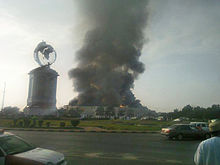
The supermarket set on fire by protesters in Suhar
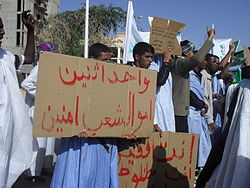
Demonstrations near the Parliament in Nouakchott, on 18 March 2011.

Mass demonstration in Casablanca in May 2011
.jpg)
Refugees at the Libyan-Tunisian border (7 March 2011)
_launching_a_Tomahawk_missile_in_support_of_Operation_Odyssey_Dawn.jpg)
Firing of a Tomahawk cruise missile from the USS Barry at a target in Libya (March 19, 2011).
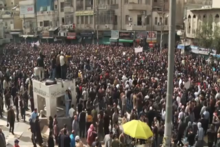
Rally in Amman on 16 November 2012
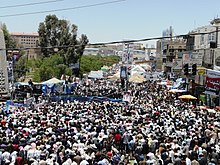
Protests in Sanaa on 27 January 2011
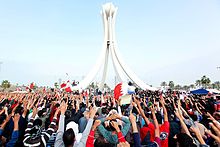
Demonstrators at the Perlenplatz (February 19, 2011)

Protesters standing on an army truck in downtown Cairo on January 29, 2011.
Questions and Answers
Q: What is the Arab Spring?
A: The Arab Spring is a term used in the media for the revolutionary wave of demonstrations and protests, riots, and civil wars in the Arab world that began on 18 December 2010.
Q: Why did the protesters participate in the Arab Spring?
A: The protesters participated in the Arab Spring because they were angry that their countries did not give them many rights and they felt that their quality of life was poor because of the governments.
Q: Did the Arab Spring result in any leadership changes?
A: Yes, the Arab Spring resulted in many leadership changes.
Q: When did the governments involved in the Arab Spring stop the protests?
A: By 2012, most of the governments involved in the Arab Spring had either been defeated and replaced or had stopped the protests.
Q: What is the Arab Winter?
A: The Arab Winter is the time period after the Arab Spring where many countries went back to having leaders that limited rights and many terrorist groups were made.
Q: Did the protests stop completely after the Arab Spring?
A: No, many protests have continued even after the Arab Spring stopped.
Q: Were the protests in the Arab Spring violent or non-violent?
A: The protests in the Arab Spring were both non-violent and violent.
Search within the encyclopedia